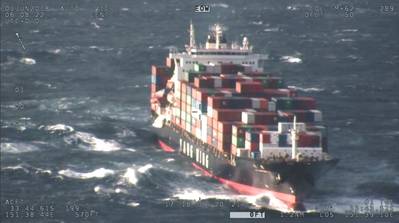Stowage Deficiencies Caused YM Efficiency Containers Loss -Report
Deficiencies in the cargo stowage arrangement ultimately caused the YM Efficiency to lose 81 containers while sailing in heavy seas off Australia in June 2018, the Australian Transport Safety Bureau's (ATSB) investigation revealed.
The Liberian-flagged vessel was en route from Taiwan to Sydney when it suddenly rolled heavily in strong gale force winds and rough seas, causing the ship to lose 81 containers overboard and another 62 containers to be damaged. The containership, operated by Taiwan shipping company Yang Ming Marine Transport Corporation, also sustained structural damage to its lashing bridges, superstructure and accommodation ladder, and spent a further five days at sea before berthing in Sydney on June 6.
According to the ATSB's report published on Thursday, the cargo loss and damage occurred because forces generated during the sudden, heavy rolling placed excessive stresses on containers stowed aft of the ship’s accommodation. This resulted in the structural failure of containers and components of the lashing system, leading to the loss of containers. All potential causes for the sudden rolling were investigated but there was insufficient evidence to establish a definitive reason for the rolling.
The weights and distribution of containers in the affected bays were such that calculated forces exceeded allowable force limits as defined in the ship’s cargo securing manual (CSM), the ATSB found. The investigation also identified that the stowage arrangement was not checked for compliance with the CSM’s calculated lashing force limitations during the cargo planning process ashore. This left sole responsibility for compliance with these requirements with the ship’s officers, with limited options to resolve deficiencies at a late stage in the process without unduly impacting operations. Further, the officers did not use the ship’s loading computer system and its lashing calculation program to check if the stowage arrangement complied as they probably did not have an adequate understanding of the system.
The ship’s managers, Yang Ming, now require checks of lashing forces during the initial cargo stowage planning stage ashore. Shore planners will receive regular training in the principles of cargo loading and securing, container stowage, and the dangerous goods functionality of the computer automated stowage planning software. Further, a stowage planning examination has been introduced for trainee stowage planners.
A review of loading computer systems in use across the Yang Ming fleet resulted in the adoption of class-specified, route-specific container stowage standards for part of the fleet.YM Efficiency and the other ships of the same size and type have been equipped with class-approved container stowage planning software systems, with the same software replicated ashore.
In addition, periodic training in the use of the ship’s loading computer system will be delivered to the responsible ship’s officers. Cargo procedures were also reviewed to ensure that the requirement for lashing forces checks to be conducted, both ashore and on board, was captured.
To date, remotely operated underwater vehicle (ROV) searches had identified 66 containers with a few washed ashore or close offshore. Five containers have been removed with 15 containers yet to be found. Substantial debris has been ashing ashore on New South Wales beaches as a result of the accident.















